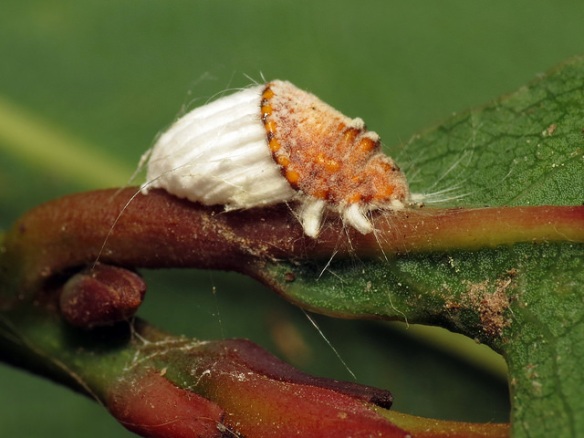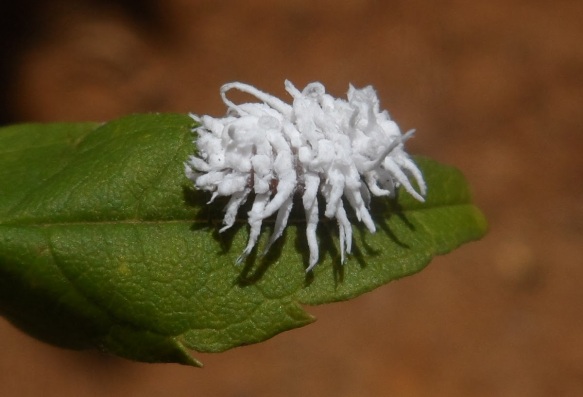It was a typical misty morning in Golden Gate Park when entomologist Kristen Vollrath spotted a fluffy white insect ambling about on a concrete barrier behind the California Academy of Sciences. She scooped up the unidentified insect and brought it down to the entomology department where it was given the nickname “popcorn” due to its puffed appearance.
At first we thought popcorn might be a mealybug, a plant pest belonging to the family Pseudoccocidae. But popcorn was no mealybug! By the end of the week, the fluffy little nubbin transformed into it’s adult form and revealed its true identity: a ladybird beetle related to the red and black-spotted “ladybugs” we commonly see in the garden.
But how were we fooled so easily? It turns out that Popcorn was a special species of ladybird beetle (Cryptolaemus montrouzieri), whose larvae masquerade as the mealybugs they prey on, a form of “aggressive mimicry” that allows them to get close to their prey before gobbling them up. Commonly known as mealybug destroyers, these humble yet murderous little beetles were brought to California from their native home in Australia for a very specific and heroic purpose: to save the citrus!

“You’re welcome”. Mealybug destroyer (Cryptolaemus montrouzieri) adult
If you were a citrus grower in 1860’s California, you would have had a lot of bugs to contend with. And I do mean bugs! True bugs to be exact, the order of insects that have what entomologists call “piercing or sucking” mouthparts. Don’t laugh! These specialized mouthparts allow true bugs to pierce plant tissues with their tiny beak-like rostrum and suck up the juices. Aphids are a well-known true bug that, along with many other plant-feeding true bugs, can cause all sorts of garden mayhem, including foliage wilt, leaf drop, and the stunted growth or even death of the plant.

Aphid feeding on a plant. See the pointy mouthparts?
In the late 1860’s the California citrus industry was facing an economic crisis brought about, not by aphids, but by an invasive species of true bug from Australia, the cottony cushion scale (Icerya purchasi). Insecticides had little effect on these puffballs, and growers, at their wits end, resorted to pulling up infested trees and burning them.

“But I’m just a lil’ poof”
Luckily there were a couple entomologists around to save the day! Albert Koebele, under the appointment of noted federal entomologist Charles Valentine Riley, had recently been transferred from his position in Washington D.C. to Alameda, California where he was studying insecticide effectiveness as well as local insect pests. He soon set his sights on fighting the cottony cushion scale scourge.
Curiously, citrus trees in Australia were largely unaffected by the cottony cushion scale even though the insect was native to the region. Riley noted this and reasoned that there must be natural predators of the cottony cushion scale in Australia that kept their numbers at a reasonable level.
And so in 1888 Riley sent Koebele on a mission to Australia to investigate potential cottony cushion scale predators that could be brought back to California. In addition to a species of parasitic fly, Koebele returned with a species of ladybird beetle called the vedalia beetle (Rodolia cardinalis).

“My appetite will save the day!” Vedalia beetle (Rodolia cardinalis)
Koebele initially released the vedalia beetles on a tented orange tree infested with cottony cushion scale insects. In a few months the beetles had multiplied prolifically and devoured their prey. When the tent was opened the beetles spread to nearby trees and soon the entire orchard was free of the cottony cushion scale! As word of the amazing results spread, citrus growers from throughout the state came to gather the vedalia beetles and release them into their orchards. They spread rapidly and by 1890 California was almost entirely free of the cottony cushion scale and all of it’s gosh-darned cottony-ness.

Happy orange tree
This idea – using nature to fight nature – is known as biological control or biocontrol, and this instance is regarded as the first successful implementation of it in the world. It can be very tricky, and, as usual, The Simpsons provides the best illustration of poorly thought out biocontrol.
In this case, however, Koebele used his entomologist know-how to implement a truly elegant solution and was seen as a local hero for growers in the state.
But his work was not over.
Several years after the cottony cushion scale had established itself in California, the citrus mealybug (Planococcus citri), another species of true bug with a deceptively cute name, was accidentally introduced from Asia around the world where it made itself quite the agricultural pest.
Mealybugs (family Pseudoccocidae), sometimes known as scale insects, are wingless as juveniles, have soft exoskeletons, and are coated in a waxy layer of protection that gives them their popcorn or puffed rice-like appearance. Males eventually change as they age, growing wings and losing their ability to feed and looking somewhat like gnats, whereas adult females retain their juvenile appearance and attach themselves to the plant where they secrete a powdery wax layer used for protection while they suck the plant juices. The female deposits masses of eggs on plants. The masses, known as ovisacs, are covered in fluffy, cottony layers of wax filaments. Juveniles feed on plant sap, which further damages them.

Citrus Mealybug (larva or adult female)
Although citrus mealybugs attack a wide range of crops as well as wild and ornamental plants, the damage they do to citrus, like causing oranges to become lumpy and discolored and possibly fall off the tree, was a nightmare for growers in California. In 1891, they pressured Riley to send Koebele back to Australia to gather more predators that could combat the growing number of mealybugs. He ended up bringing back another species of ladybird beetle, except this one was a truly cunning beast. It came to be known as THE MEALYBUG DESTROYER…aka our little popcorn!

mealybug destroyer munchies
The mealybug destroyer (Cryptolaemus montrouzieri), like the name implies, have a voracious appetite for mealybugs. To aid them in this venture, they employ a treacherous trick, which scientist’s refer to as “aggressive mimicry.” As juveniles, mealybug destroyers look very similar to mealybugs, a real-life case of a “wolf in sheep’s clothing” that allows them to get close to their prey while appearing harmless.

Mealybug destroyer Larva
Adult mealybug destroyers are predominantly brown and have no spots, unlike many of the often brightly-colored ladybird beetles (Family Coccinellidae). Female mealybug destroyers lay their eggs among the cottony egg-sack of adult female mealybugs. The larvae, whose waxy coating makes them superficially resemble mealybugs, feed on mealybug eggs and larvae. It takes almost another month for the beetles to go through their pupal stage and become adults, at which point they continue eating mealybugs as well as laying hundreds of eggs among mealybug larvae for the rest of their 2-month lifespan.

A (very accurate) depiction of a juvenile mealybug destroyer sneaking up on it’s prey. Cartoon by Rachel Diaz-Bastin.
As hoped, the mealybug destroyers devastated the citrus mealybug populations in citrus groves. But sadly these little chaps from down under got too chilly anytime it dipped much below 50 degrees ferenheit and (just like Springfield’s ill-fated gorillas), were unable to survive the winter in most areas. As a result, techniques for mass-rearing the beetle were developed for its release into groves where they could do their job during the warmer months.
In the Midwest, the mealybug destroyer is actually still used to protect ornamental plants from various species of mealybugs in greenhouses, where they stay nice and toasty year-round. They are also used for pest control in the warm wonderland at the San Francisco Conservatory of flowers in Golden Gate Park.
But, just like Kristen, you can sometimes find them out and about in coastal areas like San Francisco, where the fog provides a blanket that allows them to live much longer and fight their tiny battles in the wild, far away from their native homeland.
Thank you to Flickr creative commons folks for allowing the use of your wonderful images!
(Repost): Original Post: https://thebefuddledloris.wordpress.com/2019/03/04/a-ladybug-for-most-seasons/




